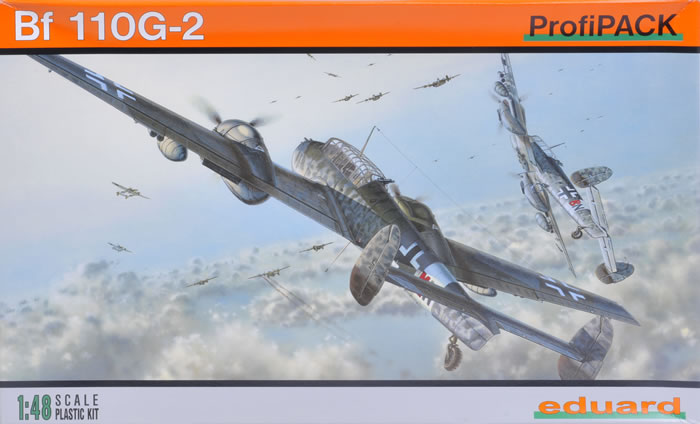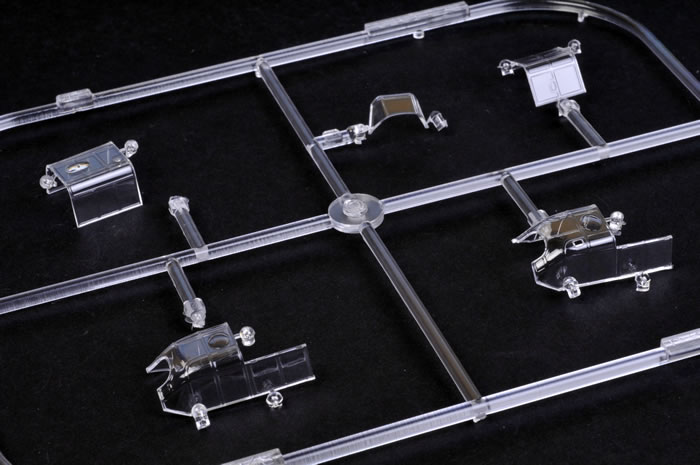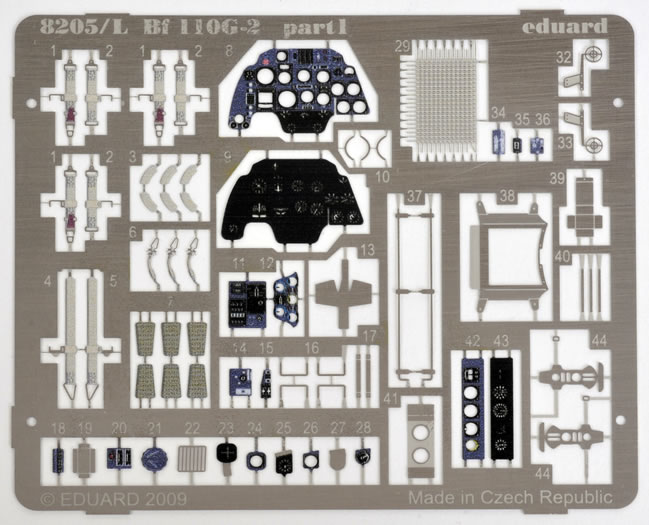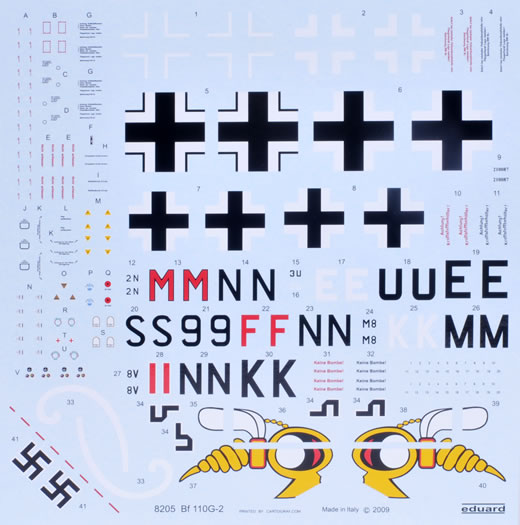|
Messerschmitt Bf 110 G-2

Eduard, 1/48 scale
S
u m m a r y |
| Catalogue Number: |
Eduard Kit No. 8205 - Messerschmitt Bf 110 G-2 |
| Scale: |
1/48 |
| Contents and Media: |
Around 264 parts in olive coloured plastic; 12 parts in clear; colour photo-etched fret; two parts in cream coloured resin; masking sheet; markings for five aircraft |
| Price: |
USD$59.95 plus shipping,
available online from Eduard
|
| Review Type: |
FirstLook |
| Advantages: |
Fabulously detailed; superb surface
features including crisply recessed panels and subtle rivet lines where
appropriate; includes comprehensive colour photo-etched parts; provides new parts for early Bf 110 G; lots of useful ordnance options; separate canopy parts for closed/open cockpit and new-style rear
position; correct size nacelles and generally very accurate; easy backdate to a Bf 110 F-2 (with a little mix-and-match); very high quality
plastic; narrow sprue attachments; attractive marking options. |
| Disadvantages: |
Modelling experience will be required; does not quite nail the spinners. |
| Conclusion: |
Easily surpasses all previous Bf 110 G kits in all scales. This is a beautifully detailed model of a historically important aircraft, but will be challenging to build in places. |
Reviewed by Brett Green

Eduard's 1/48 scale Bf 110 G is available online from Squadron.com
The Luftwaffe's heavy fighter arm, the Zerstorer Gruppen, was a prestigious force in the pre-war and Blitzkreig era. The theory of a large, twin-engine, long range, heavily armed and self-sufficient fighter was popular at the time, and worked well in practice over Poland, the Low Countries and France.
The Zerstorers fortunes turned over the skies of Britain. Along with the much maligned Stuka, the Bf 110 earned a miserable reputation during the Battle of Britain thanks to the lop sided contest with faster and more maneuverable Spitfires and Hurricanes.
Nevertheless, the useful life of the Messerschmitt Bf 110 was far from over. The Bf 110 remained a stable and reliable weapons platform for another five years. It continued in the heavy fighter and fighter-bomber role in the Meditteranean and on the Eastern Front, fitted with bombs, gun packs and additional fuel tanks.
The Messerschmitt Me 210 was developed to replace the Bf 110, but the new aircraft's flying characteristics were more dangerous to its pilots than enemy fighters. The Bf 110 was therefore treated to a major upgrade. In 1942, the Messerschmitt Bf 110 F was fitted with newly designed streamlined engine cowlings housing DB601F engines, the powerplant intended for the Me 210. These each produced 1350 hp - almost double the power of the original Jumo engines fitted to the Bf 110 B. The large spinners were the same as the Me 210 and the Bf 109 F and G series, with a cap covering the centre hole.
The Messerschmitt Bf 110 G was introduced soon after with the new DB 605 engine. This version retained the streamlined engine nacelle with some added scoops and revised inspection windows. A new style of rear canopy was introduced with a side-opening hatch replacing the gunner's sliding clamshell. The defensive armament was also upgraded to a twin 7.92mm MG 82Z machine gun. This variant was equipped with many field conversions, including 300 litre drop tanks, twin 20mm gun trays, a 37mm gun pack, air-to-air rockets and, of course, bombs beneath the wings and fuselage. In the desperate days of 1943 and 1944, the Bf 110 G was even thrown into daylight battle with American bombers, with predictably disastrous results.

Later in its development the upper nose armament was changed from 4 x 20mm cannon to two powerful 30mm MK 108 cannon.
Arguably the most important contribution made to the German war
effort by the Messerschmitt Bf 110 was as a night fighter. The role was
initially ad-hoc. From July, 1940, day fighters were simply painted
black and sent aloft to deal with British bombers, now making their
attacks under the relative protection of darkness. These early night
fighters had no additional equipment nor ground control assistance.
Enemy aircraft were held in the cone of a searchlight, and the Bf 110
would engage the bomber while it was illuminated in the beam.
The ultimate development of this long-serving marque was the Bf 110 G-4 night fighter. Sprouting ungainly radar "antlers" from its nose, with chunky flame dampers on the side of the engine nacelles and loaded with radar equipment, the tail surfaces were increased in area and fitted with larger Flettner tabs to compensate for its increased weight. "Schrage Musik" obliquely firing cannon were frequently fitted inside the cockpit too. These radar-equipped Bf 110 G-4s represented an effective and constant threat to Bomber Command from 1943 until the last days of the Second World War.
The Bf 110 G in 1/48 scale
Although Fujimi released their 1/48 scale Messerschmitt Bf 110 C in 1973, we had to wait until the 1980s for the first Bf 110 G conversion. Arbas's conversion was a typical resin product of its day - crude and incomplete - but at least it provided the basic parts to build a 1/48 scale Bf 110 G.
In 1992, Japanese company Mauve released a limited-edition Bf 110 G-4 with new plastic sprues, plus metal and photo-etched parts added to Fujimi's kit. This was followed soon after by a Bf 110 G-2 day fighter. Although Mauve's kits were accurate in outline and featured high quality parts, they inevitably suffered from some of the shortcomings of the ancient Fujimi parts, including non-existent wheel well detail. It was also cripplingly expensive. I bought both kits in the early 1990s for more than $100 each - almost unheard of for a 1/48 scale kit at the time. The Mauve kits have long since faded into unavailability.
Revell-Monogram stepped onto the scene with their new Bf 110 G in 1997. The kit featured nice (albeit slightly soft) detail in the cockpit and the wheel wells. There was also a much lamented moulding flaw on the upper rear fuselage, which was easily repaired, and seriously undersized engine nacelles and spinners, which were not so easily fixed. The spinners were 2 millimetres too small in diameter. This may sound like a minor discrepancy, but it is very noticeable on the finished model. The problem was compounded by the engine nacelles, which were undersized by the same proportion. Cutting Edge released a comprehensive resin correction set in 2003, but this was best suited to experienced modellers and has been unavailable since the demise of Meteor Productions.
And so, in 2009 we are still waiting for the ultimate accurate Messerschmitt Bf 110 G in 1/48 scale.
Enter Eduard.
Eduard's 1/48 scale Bf 110 family was launched in 2007 with their excellent Bf 110 E, followed by the C and D variants. These are beautifully detailed and accurate kits, and clearly the best Bf 110s in 1/48 scale.
Similar to the real aircraft, Eduard's new 1/48 scale Bf 110 G-2 shares most parts in common with these earlier releases. Let's take a closer look at what is new in this box.
What's New
Eduard's 1/48 scae Messerschmitt Bf 110 G-2 provides three brand-new plastic sprues, an additional clear sprue, revised photo-etch and two resin air filters.
The first thing I did was to compare the diameter of the propeller spinners to the base plate of a Hasegawa Bf 109 G spinner. I am delighted to report that they are a very close match. The shape of the new G-type engine nacelles looks very good too, including the subtle bulge just aft of the main cowling.
This sprue also contains the new propellers, instrument panels, cockpit floor, new 20mm cannon for the sub-floor, small vertical flying surfaces and a new tail wheel strut with scissor link.
Another large new sprue contains the remaining cockpit parts, the wing tip pitot tube and a second set of (unused for now) horizontal stabilisers. Mounts for FuG 202 radar (an early radar usually associated with the four machin-gun nose and small vertical tail) are included on this sprue, hinting at the next release.
The third new sprue supplies the twin 20mm and 37mm under-fuselage gun packs.
The wing sprue has a new identification letter (W) but I cannot see any external differences beyond subtler surface detail inboard of the engine nacelles. It is possible that the hump has been tweaked to fit the new nacelle parts though.
The new clear sprue contains the revised rear canopy section with the side-opening navigator's hatch. An alternate rear section is provided with holes for the night fighter's upward-firing Schrage Musik cannon.

Two new photo-etched frets offer lovely colour cockpit details for items including the instrument panel, navigator's mesh seat and engine instruments, harness straps and more. Twin ring sights for the new Zwilling defensive machine gun are also supplied.

Resin sand filters are also offered as an option. These were seen fitted to some Bf 110 Gs in Russia as well as the Meditteranean front.

Many of the updates already available for Eduard's early Bf 110s will be applicable to this release too, including Quickboost's one-piece exhaust stacks (a Godsend!), machine gun barrels and separate leading-edge slats; and Aerocast's control surfaces and wheels.
Bf 110 F Backdate
It will not be difficult to backdate this model to a Bf 110 F with a little mixing and matching of a few spare parts from Eduard's early Bf 110 kits.
The engine nacelles for the Bf 110 F were almost indistinguishable from the Bf 110 G in shape. The Bf 110 G's nacelles were only 21mm wider than the F (around .826"), which will be hard to pick in 1/48 scale. You you will just need to slice off the small scoops moulded on the front of the engine nacelles. Three inspection windows will also need to be drilled out where the triangular ports are scribed onto the kit nacelles.
The F shared the G-2's four-gun nose and small tail surfaces, but was normally fitted with the earlier style of rear canopy and single defensive machine gun. Eduard supplies two sets of rear canopies in its Bf 110 C/D/E kits - one open and one closed. You will be able to pilfer one of these for your early Bf 110 F conversion. Please note that later production Fs were upgraded to the side-opening rear canopy with the twin machine guns, so check your references carefully.
The only other external differences are the use of the large DF loop and the blind landing antennae under the fuselage (still offered in this kit as part nos. G30 and PE 37) and the pitot tube mounted under the starboard wing (also per the C/D/E). This last item will be easy enough to build from scratch.
The Details...
Images of the remaining sprue parts may be found in my earlier review of Eduard's Bf 110 C release
This release continues Eduard's recent tradition of world
class quality
injection moulded parts, remarkable detail and colourful markings.
The styrene parts for the kit are attached to eight sprues via fine connectors.
Moulding quality is superb. I could not find a single sink mark or
ejector pin in any area that will be visible on the finished model.
Crisply recessed panel lines are partnered with suitably subtle rows
of rivets. I like the treatment of the fabric control surfaces too, with
rib tape detail being the most prominent feature - no massive sagging of
fabric.
The fuselage is broken down into the main halves with a separate nose
(upper and lower) plus an insert for the deck immediately aft of the
cockpit.
The cockpit is beautifully fitted out with a combination of delicate
plastic and colour photo etched parts.
The lower fuselage cannon are
visible through the fuselage floor, and plenty of spare ammunition is
provided.
The nose is fully equipped with four MG 17 machine guns and
ammunition feeds plus oxygen bottles. These may be displayed by posing
the separate gun cowl open.
The wings are moulded with the flaps and leading edge
slats in the closed position. This may disappoint some modellers, but I
did a quick check of several books and nearly half of the Bf 110s were
parked with the slats and flaps up. If you really want to drop the flaps
and/or slats, the kit engineering will make this task fairly
straightforward with the bulges behind the nacelles moulded as part of
the bottom of the kit flaps. Also, Quickboost now offers a separate set of leading edge slats for the Edaurd Bf 110 C/D/E releases that will fit this kit too.
Ailerons are provided as separate parts.
Wheel well detail is excellent
The shape of Bf 109 F/G and Bf 110 G spinners has proved elusive to manufacturers. Eduard has done a pretty good job with theirs, although the openings for the propeller blades appear to be too large and lack their characterisic teardrop profile, pinched in at the base.

Eduard masks are also included to ease the pain of
painting that maze of canopy frames.
Marking Options
Five attractive marking options are offered, all in mid-war RLM 74/75/76 greys.
Decals are beautifully printed, with perfect register
and colour saturation.

The specific subjects are as follows:
-
5./ZG 1, Wells, Austria - Winter, 1943-44
-
5./ZG 1, Monte Covino, Italy - Summer, 1943
-
10./ZG 26 (III.JG 5), Gossen, Norway - Spring, 1945
-
4./ZG 76, Prague, Czechoslovakia - Spring, 1944
-
5./NJG 200, Russia, 1943
I am delighted that we finally have an accurate and well-detailed Messerschmitt Bf 110 G in 1/48 scale.
This is a beautifully presented kit. The high parts count and some of the smaller and delicate parts mean that some modelling experience will be necessary before tackling this project, but there can be little doubt that a stunning replica will be the result of your efforts.
I am looking forward to building this baby!
Thanks to Eduard for the sample
Review Text Copyright © 2009 by
Brett Green
Page Created 21 July, 2009
Last updated
24 July, 2009
Back to HyperScale Main Page
Back to Reviews Page

|
